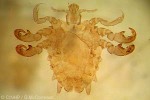Cook Islands Biodiversity Database
Species Page
Pthirus pubis
Pubic Louse
Multimedia & Additional Resources
| Type | Description | Download |
| Adult specimen | 61KB | |
| Human Louse vs Pubic Louse | 34KB |
General Information
Cook Islands Distribution
| Southern Group: Present Makatea: | ||||||||
RR |
MG |
AT |
MK |
MT |
AK |
PL |
TK |
MN |
| Northern Group: | |||||
TN |
MH |
RK |
PK |
NS |
SW |
Pests & Hosts
| Relationship | Hosts |
| Parasite - external | Homo sapiens, |
Scientific Taxonomy
Pthirus pubis (L., 1758)
SYNONYMS: Phthirus pubis [misspelling]; Pediculus pubis [O]
TAXONOMY: ANIMALIA; ARTHROPODA; ATELOCERATA; HEXAPODA; INSECTA; PTERYGOTA; Phthiraptera; Anoplura; PHTHIRIDAE. COMMENT: The Pubic Louse was named in1758, by Linnaeus as Pediculus pubis. In 1815 Leach put this louse into a new genus and published its new name as Pthirus pubis. In doing this he, or a typesetter, dropped the first "h" of the Greek word Phthirus. Two years later Leach corrected the spelling to Phthirus pubis. However, the international rules on biological names requires that the first published spelling be maintained and therefore the correct name is Pthirus pubis.
Pthirus is the only genus in the family PHTHIRIDAE (with the "h"!), and the genus has only two species: Pubic Louse (Pthirus pubis) and Gorilla Louse (Pthirus gorillae). [3/2004, G.McCormack based on data at www.phthiraptera.org]
More Information
SIGNIFICANCE NOTES -
NEGATIVE SIGNIFICANCE: Ectoparasite of people - rare. Comments: A sedenatary ectoparasite attached to the base of hairs, usually in the pubic area. The bites vary from painless to severe itching, and sometimes form blue spots to 30mmØ. Not known to transmit diseases.
GENERAL NOTE: A sedentary louse attached to the base of hairs usually in the public area, but can be elsewhere. Typically transmitted by sexual intercourse, but sometimes from infected toilet seats, clothing and bedding.
Breeds on people only, but sometimes lives on other mammals. Eggs glued to hairs. They hatch in about 7 days, larval stages for 2 weeks, and adult can lay eggs within a weeks, and lives about a month.
Reactions of people to the bite vary from unnoticed to severe itching. The bite area sometimes develops a painless irregular blue spot 1-30mmØ. This reaction of the louse saliva develops a few hours after the bites and last several days.
Vouchers & References
Vouchers:
None Recorded.
References:
None recorded.
Data Update History (information):
zTX, zB02, zM02, zupM04a, zD02
Web Resources
Citation Information
McCormack, Gerald (2007) Cook Islands Biodiversity Database, Version 2007.2. Cook Islands Natural Heritage Trust, Rarotonga. Online at http://cookislands.bishopmuseum.org. ![]()
Please refer to our use policy.

